Aim: To study the reaction between calcium oxide and water.
Activity:
Take some quick lime (Calcium oxide - CaO) in a beaker. Add water to it slowly.
Touch the beaker as shown in the figure 1.3.
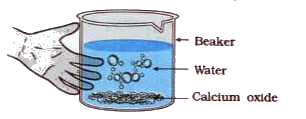
What do you feel by touching the beaker outside ?Solution in Gujrati
By touching the beaker, it is observed that the beaker becomes warm since, heat is evolved during reaction.
Topper's Solved these Questions
- CHEMICAL REACTIONS AND EQUATIONS BOOK - KUMAR PRAKASHANCHAPTER - CHEMICAL REACTIONS AND EQUATIONS EXERCISE - QUESTIONS AND ANSWERS (ACTIVITY) 1.5
3 Videos
- CHEMICAL REACTIONS AND EQUATIONS BOOK - KUMAR PRAKASHANCHAPTER - CHEMICAL REACTIONS AND EQUATIONS EXERCISE - QUESTIONS AND ANSWERS (ACTIVITY) 1.6
2 Videos
- CHEMICAL REACTIONS AND EQUATIONS BOOK - KUMAR PRAKASHANCHAPTER - CHEMICAL REACTIONS AND EQUATIONS EXERCISE - QUESTIONS AND ANSWERS (ACTIVITY 1.3)
4 Videos
- CARBON AND ITS COMPOUNDSBOOK - KUMAR PRAKASHANCHAPTER - CARBON AND ITS COMPOUNDSEXERCISE - Practical Skill Based Questions With Answers
10 Videos
- METALS AND NON-METALSBOOK - KUMAR PRAKASHANCHAPTER - METALS AND NON-METALSEXERCISE - PRACTICE SKILL BASED QUESTIONS WITH ANSWERS
5 Videos
Similar Questions
Aim : To study the decomposition of ferrous sulphate on heating
Activity:
Take approximately 2 g of ferrous sulphate crystals in a dry boiling tube.
Heat the boiling tube over the flame of a burner.
Observe the colour of the ferrous sulphate crystals carefully during the heating.
Observe the colour of the crystals after heating it.
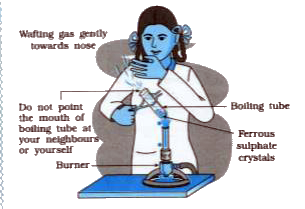
What is the colour of crystals of ferrous sulphate ?
View SolutionAim : To study the decomposition of lead nitrate.
Activity:
Take about 2g of lead nitrate powder in a boiling tube.
Hold the boiling tube with a pair of tongs and heat it over the flame of a burner.
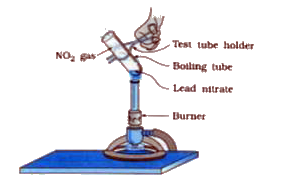
Which gas is evolved from boiling tube on heating lead nitrate ?
View SolutionAim: To study the reaction between zinc metal and dilute sulphuric acid.
Caution: Use the acid with care.
Activity:
Take a conical flask.
Add a piece of zinc granules in it.
Then add dilute hydrochloric acid or dilute sulphuric acid.
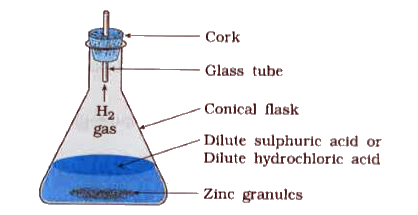
What appears around the zinc granules ?
View SolutionAn organic compound 'A' is widely used to preserve the pickles and has a molecular formula C2H4O2. This compound reacts with ethanol to form a sweet smelling compound 'B'.
Identify the compound 'A'.
View SolutionMention three safety measures essential while performing the reactivity series experiment in the laboratory
View SolutionApparatus: Test tube, glass rod, beaker, Bunsen burner, etc. Chemicals: Hydrochloric acid, ammonia solution, magnesium strip, quick lime, etc. Activity 3: Take water in a beaker up to half of its capacity. Add a few pieces of quick lime (calcium oxide, CaO) to it. What will you observe?
View SolutionTake about 1 gm of calcium oxide in beaker and add 10 ml of water then, which of the following could be formed
View SolutionApparatus: Test tube, glass rod, beaker, Bunsen burner, etc.
Chemicals: Hydrochloric acid, ammonia solution, magnesium strip, quick lime, etc.
Activity 3: Take water in a beaker up to half of its capacity. Add a few pieces of quick lime (calcium oxide, CaO) to it. What will you observe?
View SolutionAim: To study the reaction between calcium oxide and water. Activity: Take some quick lime (Calcium oxide - CaO) in a beaker. Add water to it slowly. Touch the beaker as shown in the figure 1.3. What is formed by reaction of quick lime with water ? Write reaction.
View SolutionAim: To study the reaction between calcium oxide and water.
Activity:
Take some quick lime (Calcium oxide - CaO) in a beaker. Add water to it slowly.
Touch the beaker as shown in the figure 1.3.
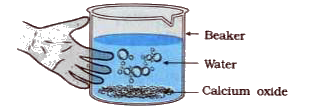
What is called the reaction occurring between quick lime and water ?
View SolutionAim: To study the reaction between calcium oxide and water.
Activity:
Take some quick lime (Calcium oxide - CaO) in a beaker. Add water to it slowly.
Touch the beaker as shown in the figure 1.3.
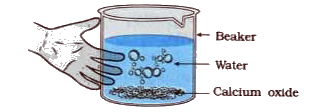
What is slaked lime ?
View SolutionApparatus: Test tube, glass rod, beaker, Bunsen burner, etc. Chemicals: Hydrochloric acid, ammonia solution, magnesium strip, quick lime, etc. Activity 3: Take water in a beaker up to half of its capacity. Add a few pieces of quick lime (calcium oxide, CaO) to it. What will you observe?
View SolutionWater is added to quick lime in a beaker and you touch the bottom of the beaker what do you notice ? What is the reason ?
View Solutionजब हम कैल्सियम ऑक्साइड (बिना ब्रझा हुआ चूना) में पानी डालते हैं तो होने वाली अभिक्रिया है
View Solutionഒരു ബീക്കറിലെ ജലത്തിൽ അല്പം നീറ്റുകക്ക (കാൽസ്യം ഓക്സൈഡ്) ചേർത്ത് ഇളക്കുക. ബീക്കറിൽ നിന്നും അൽപ്പം തെളിഞ്ഞ ലായിനി ഒരു ടെസ്റ്റ് ട്യൂബിലെടുത്ത് അതിലേക്ക് ഒരു തുള്ളി ചുവന്ന ലിറ്റ്മസ് ലായിനി ചേർക്കുക. എന്താണ് നിരീക്ഷിച്ചത്.
View Solution
